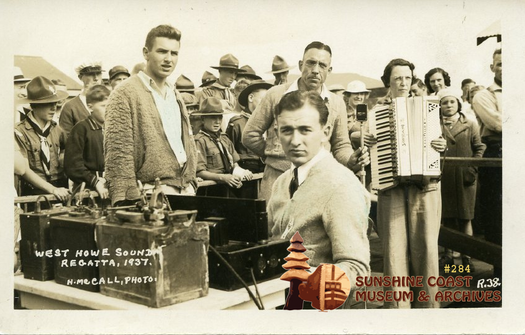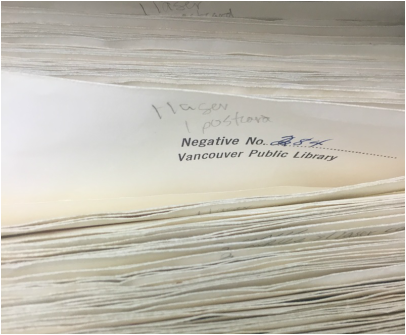The first step is to look into the database for the artifact, photo, or object that you are interested in. In our database you can do either a broad or specific search using keywords to match the description of the artifact/photo/object. In cases where we are following a research request we would use key words from the request (eg. place, date, event) to narrow our search. In this case the research request we received specified that they wanted information about past musical events, so I used keywords such as ‘orchestra’ and ‘regatta’. This photo, #284, is actually a postcard shot by Helen McCall that depicts a scene from the 1937 West Howe Sound Regatta. It is a surprisingly striking photograph for the technology of the day, and showcases some interesting content, so I was excited to follow this photo through the process of taking it out of the archives.
Step 2: Donor Form
The Donor Form is an important part of the initial process of acquiring an artifact. Usually when a donation is brought in the donor form is filled out, and includes the relationship of the donor to the object, and the history of the item up until the point of bringing it into the Museum. This is an important step not only for museum administration, but for research purposes. If we know where the donation came from we can better understand its significance to the community!
Unfortunately there is no Donor form for photo #284. With such a low number we can tell that this postcard was a very early acquisition of the museum’s, which means protocols for Donor Forms were not yet established.
The next step is probably the most simple, but the most fun. This is where we get to physically go into the archive space and look for our item. Most of the time the photo is in the archives, but sometimes it is on display in an exhibit or is in the oversized archive storage.
Photo #284 was in the archive right where it was supposed to be! Photos are always welcome additions to the archive as they don’t take up much space and can be stored closely together, as seen above.
Here we can see the photo comes in an acid-free folder, to prevent decaying of the photo, and that both the negative and a print of the postcard have been preserved. When the negative is preserved it is often referred to as the ‘original’, as reproductions (such as the postcard pictured) often look a little different than the negative does.
When handling artifacts as a museum employee it is important to always wear white cotton gloves and not to dawdle. Both the natural oils on your hands and prolonged exposure to light can damage the photo.
After you’re done examining the photo, you simply put the picture and negative (if it has one) back into its acid-free folder and back into the archive from whence it came.
There you have the process that a museum employee would take to pull an artifact, photo, or object from the archives. We do this most often when there are research requests, so please send your inquiries in! From artifacts to photos to newspapers, we have them all. If for some reason you can’t make it into the museum, take a look at our online photo and newspaper collections.





 RSS Feed
RSS Feed
